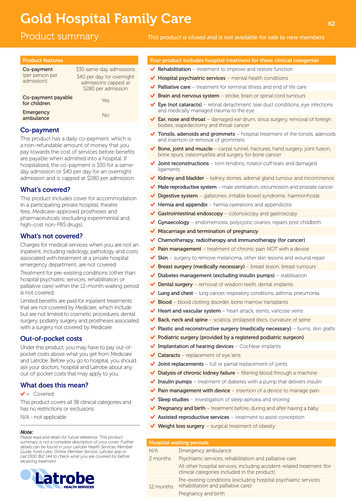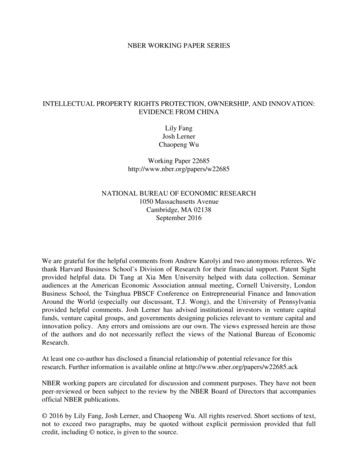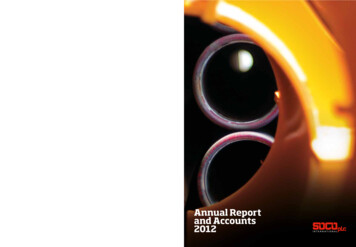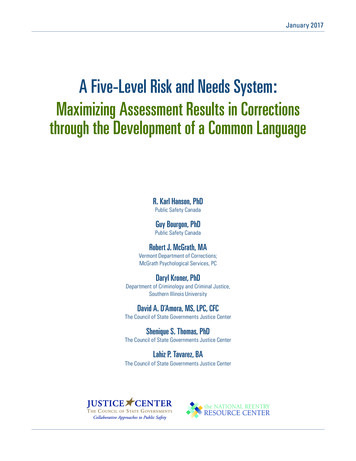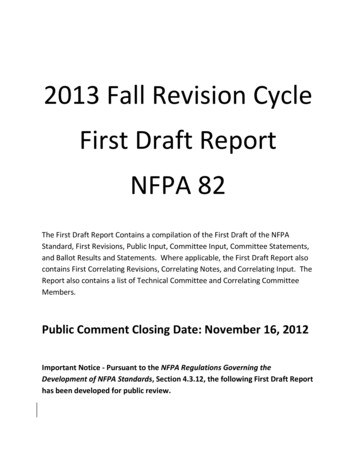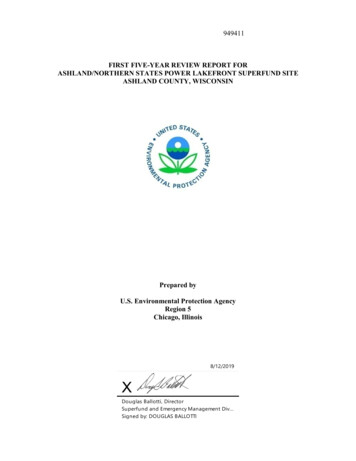
Transcription
949411FIRST FIVE-YEAR REVIEW REPORT FORASHLAND/NORTHERN STATES POWER LAKEFRONT SUPERFUND SITEASHLAND COUNTY, WISCONSINPrepared byU.S. Environmental Protection AgencyRegion 5Chicago, Illinois8/12/2019XDouglas Ballotti, DirectorSuperfund and Emergency Management Div.Signed by: DOUGLAS BALLOTTI
Table of ContentsLIST OF ABBREVIATIONS & ACRONYMS .4I. INTRODUCTION . .5II. RESPONSE ACTION SUMMARY . 6Basis for Taking Action . 6Response Actions . 10Status of Implementation . 14Institutional Controls . 17Systems Operations/Operation & Maintenance . 18III. PROGRESS SINCE THE LAST REVIEW . 18IV. FIVE-YEAR REVIEW PROCESS . 18Community Notification, Involvement & Site Interviews . 18Data Review . 19Site Inspection. 19V. TECHNICAL ASSESSMENT . 19QUESTION A: Is the remedy functioning as intended by the decision documents? . 19QUESTION B: Are the exposure assumptions, toxicity data, cleanup levels, andRAOs used at the time of the remedy selection still valid? . 20QUESTION C: Has any other information come to light that could call into questionthe protectiveness of the remedy? . 20VI. ISSUES/RECOMMENDATIONS . 20VII. PROTECTIVENESS STATEMENT . 21VIII.NEXT REVIEW . 222
Figures and TablesTable 1 – Summary of Planned and/or Implemented ICsAppendicesAppendix AExisting Site InformationAppendix BReference ListAppendix CAttachmentsAttachment 1Attachment 2Attachment 3Attachment 4Attachment 5Attachment 6Attachment 7Ashland Site MapsCOC parameter listNewspaper AdSite Inspection ChecklistMonitoring Well LocationsSummary of Groundwater MonitoringEffluent Discharge Results3
LIST OF ABBREVIATIONS & WDNRWNPDESAdministrative Order on ConsentApplicable or Relevant and Appropriate RequirementsBaseline Ecological Risk AssessmentConsent DecreeComprehensive Environmental Response, Compensation, and Liability ActCode of Federal RegulationsContaminants of ConcernCancer RiskCentral Tendency EvaluationDense Non-aqueous Phase LiquidEnvironmental CovenantUnited States Environmental Protection AgencyExplanation of Significant DifferencesFeasibility StudyFive-Year ReviewInstitutional ControlHuman Health Risk AssessmentLight Non-aqueous Phase LiquidMaximum Contaminant LevelManufactured Gas PlantNon-aqueous Phase LiquidNational Oil and Hazardous Substances Pollution Contingency PlanNational Priorities ListNorthern States Power Company of WisconsinOperation and MaintenancePolynuclear Aromatic HydrocarbonsPotentially Responsible PartyRemedial ActionRemedial Action ObjectiveResource Conservation and Recovery ActRemedial DesignRemedial Design/Remedial ActionRemedial InvestigationRemedial Investigation/Feasibility StudyRecord of DecisionAshland/Northern States Power Lakefront Superfund SiteSurface-Weighted Average ConcentrationSemi-Volatile Organic CompoundsUnlimited Use/Unrestricted ExposureVolatile Organic CompoundsWisconsin Department of Natural ResourcesWisconsin National Pollutant Discharge Elimination System4
I. INTRODUCTIONThe purpose of a Five-Year Review (FYR) is to evaluate the implementation andperformance of a remedy in order to determine whether the remedy is and will continueto be protective of human health and the environment. The methods, findings, andconclusions of reviews are documented in FYR reports such as this one. In addition, FYRreports identify issues found during the review, if any, and document recommendations toaddress them.The United States Environmental Protection Agency (EPA) is preparing this FYRpursuant to the Comprehensive Environmental Response, Compensation, and LiabilityAct (CERCLA) Section 121, consistent with the National Contingency Plan (NCP)(40C.F.R. Section 300.430(f)(4)(ii)), and EPA policy.This is the first FYR for the Ashland/Northern States Power Lakefront Superfund Site(Site). The triggering action for this statutory review was the start of the remedial action(RA). The FYR has been prepared due to the fact that hazardous substances, pollutants,or contaminants remain at the Site above levels that allow for unlimited use andunrestricted exposure (UU/UE).The Site consists of one operable unit (OU) and will be addressed in this FYR. However,the Site remedy was separated into two phases: 1) Phase 1: upland remedy (onshore) and2) Phase 2: sediment remedy (offshore).Scott Hansen, Remedial Project Manager with EPA led the Ashland/NSP LakefrontSuperfund Site FYR. John Sager, Project Manager with the Wisconsin Department ofNatural Resources (WDNR) assisted in the review. On June 18, 2018, EPA notifiedWDNR of the initiation of the FYR.Site BackgroundThe Site is located in Ashland, Ashland County, Wisconsin (see maps in Appendix C,Attachment 1). The Site consists of 25 acres of upland (onshore) and 16 acres offshore(sediment located along the shore of Lake Superior). The Site contains: (i) propertyowned by Northern States Power Company, a Wisconsin corporation, doing business asXcel Energy, a subsidiary of Xcel Energy Inc. (NSPW). This property included theformer Manufactured Gas Plant (MGP) facility; (ii) a portion of Kreher Park, a Cityowned property fronting on the bay that included the former municipal waste watertreatment plant (WWTP); (iii) an inlet of Chequamegon Bay containing contaminatedsediment directly offshore from the former WWTP; (iv) a railroad right-of-way owned bythe Wisconsin Central Ltd., and formerly owned by the Soo Line Railroad; and (v) OurLady of the Lake Church/School, as well as private residences. The Site is bounded byUS Highway 2 (Lake Shore Drive) to the south, Ellis Avenue and its extension to theCity marina to the west, Prentice Avenue and its extension to a boat launch to the east,and a line between the north termini of the marina and the boat launch to the north. More5
information regarding Site Background can be found in Appendix A – Existing SiteInformation.FIVE-YEAR REVIEW SUMMARY FORMSITE IDENTIFICATIONSite Name: Ashland/Northern States Power LakefrontEPA ID: WISFN0507952Region: 5State: WICity/County: Ashland/AshlandSITE STATUSNPL Status: FinalMultiple OUs?NoHas the site achieved construction completion?NoREVIEW STATUSLead agency: EPA[If “Other Federal Agency”, enter Agency name]:Author name (Federal or State Project Manager): Scott HansenAuthor affiliation: EPAReview period: 6/18/2018 – 4/30/2019Date of site inspection: 11/27/2018Type of review: StatutoryReview number: 1Triggering action date: 5/23/2014Due date (five years after triggering action date): 5/23/2019II. RESPONSE ACTION SUMMARYBasis for Taking ActionIn 1989, during exploratory work to expand the WWTP, contaminated soil andgroundwater were encountered by the City of Ashland. The City notified WDNR,subsequently closed the WWTP, and built a new WWTP facility a few miles away. In6
1994, WDNR initiated an investigation and evaluation of the area to characterize theextent of contamination on the property.The primary contaminants at the Site are derived from manufactured gas plant wastes inthe form of coal tars, including volatile organic compounds (VOCs) and polycyclicaromatic hydrocarbon (PAH) compounds. Additionally, some free-phase hydrocarbonsproduct (free product) derived from the coal tars is present as non-aqueous phase liquid(NAPL), and has impacted soils, groundwater, and sediments. The NAPL referenced inthis document includes both light non-aqueous phase liquid (LNAPL) and dense nonaqueous phase liquid (DNAPL).DNAPL was encountered in the upper reaches of the Filled Ravine near the former MGPfacility on the NSPW property to the former lake shore, in isolated areas of Kreher Parkincluding the former “seep” area, in the nearshore sediments, and in the upper elevationsof the Copper Falls Formation, which behaves as a confined aquifer under the formerMGP in the Upper Bluff portion of the Site. DNAPLs encountered in the Filled Ravine(near the former MGP facility) and at isolated areas at Kreher Park were encountered atthe base of these fill units overlying the Miller Creek Formation. The Miller CreekFormation is the confining unit for the underlying Copper Falls aquifer. LNAPLs werealso observed across much of Kreher Park as oily sheen in the underlying wood wastelayer encountered during a test pit investigation at the Park.DNAPL was also encountered in sediments in portions of the affected inlet, although theDNAPL is less defined than at on-shore locations due to the dynamic conditions in theaffected sediments. The most highly contaminated sediments (including areas ofDNAPL) are subsurface and nearest the shoreline; however, releases of contamination tothe surface water have been documented, specifically during high energy events. It isimportant to note that nearly all of the significant wood waste/wood debris is locatedwithin the most highly contaminated areas of the inlet nearest the shoreline.DNAPLs in the deep aquifer correspond to high levels of VOCs in groundwater ( 50,000µg/L), which is surrounded by a dissolved phase contaminant plume that extends northfrom the NAPL area in the direction of groundwater flow.Contaminants of ConcernThe source of the contaminants of concern (COCs) at the Site was determined to be thehistorical releases from the former MGP operations from the 1880s to 1947, withpotential contributions from historic lumber operations and solid waste disposal. Otheractivities such as the construction, expansion and operation of the former WWTP mayalso have redistributed contamination at the Site.The COCs at the Site are typical by-products of MGP processes. The groundwater, soil,and sediment at the Site are contaminated predominantly with VOCs and semivolatile7
organic compounds (SVOCs). The predominant subgroup of SVOCs are PAHs. The mostcommonly occurring VOC is benzene, and the most commonly occurring PAH isnaphthalene. Metals (e.g., lead and arsenic) have been detected at varying concentrationsand are associated with natural conditions, fill, and former MGP process wastes. TheVOCs and PAHs were derived from the former MGP operations located on the UpperBluff portion of the Site.The ongoing sources of the COCs are primarily the free-product zones of NAPL thathave been identified since investigations began at the Site in 1994, and further refinedduring the remedial investigation (RI) sampling performed in 2005. These free-productzones consist of both DNAPL and LNAPL and are consistent with MGP wastes. TheseMGP wastes are located in the aquifers, subsurface soils and sediments.All data from historic investigations and the 2005 RI were compiled into one database. Alarge dataset of organic compounds was analyzed during the earlier investigations at theSite, with a smaller dataset available for metals and inorganics. The 2005 RI Work Planrequired sampling of a smaller set of VOCs, PAHs and metals/inorganic analytescommon to all media (a slightly expanded list of PAHs was analyzed for sediments forpurposes of ecological evaluation). During preparation of the RI, EPA approved anamended list of compounds which included the analytes listed in the 2005 RI Work Planand additional compounds previously analyzed that exceeded regulatory limits. Theseadditional compounds were limited to those which were historically measured at leastonce in excess of 10 times an applicable regulatory standard. The amended final COCparameter list that was approved by EPA is included in Appendix C, Attachment 2.Risk CharacterizationAs part of the RI, NSPW prepared a Human Health Risk Assessment (HHRA) and aBaseline Ecological Risk Assessment (BERA) for the Site to evaluate potential risks tohuman health and the environment if no action is taken. The HHRA and BERAcharacterized current and future threats or risks to human health and the environmentposed by contaminants at the Site. The risk assessments provided the basis for takingaction and identified the contaminants and exposure pathways that needed to beaddressed by the RA. The HHRA and BERA determined that the COCs for the Site arePAHs and VOCs in soils, sediment and groundwater and that cleanup to levels withinEPA’s risk range will be protective of human health and the environment at the Site forcurrent and future use.Human Health RisksThe results of the HHRA for the Site indicated that seven exposure pathways result inestimated risks that exceeded EPA’s target risk range (CR of 10-4 to 10-6 and an HI 1)and eight exposure pathways result in estimated risks that were either equivalent to orexceeded the WDNR’s threshold (CR 1 10-5 and HI 1).8
Cancer risks to a subsistence fisher (finfish) were equivalent to the upper-end of the EPAtarget risk range, but greater than the WDNR threshold of a CR of 1 10-5. Noncarcinogenic risk was within acceptable limits for both EPA and WDNR.Risks to recreational children (surface soil) were equivalent to the WDNR risk threshold.However, risks to adolescent and adult receptors exposed to surface soil were below theEPA acceptable risk range and below the WDNR risk threshold.Risks to waders and swimmers (sediments), industrial workers (surface soil), andmaintenance workers (surface soil) were all within EPA’s target risk range of 10-4 to 10-6for lifetime cancer risk and a target HI of less than or equal to 1 for non-cancer risk butwere greater than the WDNR threshold of 1 10-5 for lifetime cancer risk.These risk estimates were based upon the reasonable maximum exposure (RME)scenarios for potential cancer risks and non-cancer risks. The conclusions were based onassumed exposures to soil in the Filled Ravine area (for residential receptors), to soil inthe Filled Ravine, Upper Bluff and Kreher Park areas (for construction worker receptors),and to indoor air samples collected at the NSPW Service Center. Carcinogenic risksbased on central tendency evaluation (CTE) scenarios indicated that only the residentialreceptor exposure to soil (all soil depths to 10 feet below ground surface (bgs)) wasestimated to be at a CR of 1 10-4, which was at the upper-end of the EPA target riskrange and greater than the WDNR threshold. Non-carcinogenic risks for the residentialreceptor (for soil depths 0-1 foot and 0-3 feet bgs) and risks associated with theconstruction scenario were within acceptable levels. However, residential receptorexposure to subsurface soil is not expected given the current and potential future land useof the Site. Residential risks associated with exposures to surface soil (0-1 feet bgs) werewithin the target risk ranges.Although the results of the HHRA indicated risks to the construction workers under theRME conditions exceeded EPA’s target risk levels, the assumptions used to estimaterisks to this population were conservative and assumed the worst case. Given both thecurrent and future land use of the Site, it is unlikely that construction workers would beexposed to soil in the Filled Ravine and Upper Bluff. The most likely scenario for thefuture construction worker is exposure to soil within 0 to 4 feet bgs at Kreher Park (atypical depth for the installation of underground utility corridors), as most activitiesassociated with the implementation of the future land use would be associated withregrading, landscaping, and road or parking lot construction.At the request of the Wisconsin Department of Health Services (WDHS), risks were alsoestimated for construction workers exposed to “oily materials” in groundwater via dermalcontact and for swimmers and waders who may be exposed to oil slicks in surface watervia ingestion and dermal contact. Because no media-specific concentrations wereavailable for either scenario, risks were estimated using analytical data collected from the9
product stream from the active NAPL recovery system for the Copper Falls aquifer orchemical-specific solubility values detected in the DNAPL sample. Risks to constructionworkers exposed to “oily material” in groundwater and adult swimmers and wadersexposed to “oil slicks” in surface water were greater than both the EPA upper risk range(CR 1 10-4 and HI of 1) and WDNR threshold (CR 1 10-5 and HI of 1).Ecological RisksThe results of the ecological risk characterization indicated that there were unacceptablerisks to the benthic macroinvertebrate community from exposure to contaminatedsediment at the Site. Two lines of evidence, bulk sediment chemistry and sedimenttoxicity testing, indicated an unacceptable risk to the benthic community. Effectsobserved from field surveys of the existing benthic community indicated effects that wereless dramatic than those demonstrated in the laboratory toxicity studies, but interpretationof the field survey data was very difficult due to a high degree of variability and lack ofcomparability between reference and site stations.However, the fact that hydrocarbons were sporadically released from the Site sedimentduring some high energy meteorological events or when disturbed by other activitiesindicates the potential for impact to the benthic community that may not have been fullymeasured by the benthic community studies conducted to support the RI. Since theimpact from releases was not fully measured during the RI and there was no evidencethat showed impairment of populations and communities of these receptors inhabiting thewaters of Chequamegon Bay, the full impact from these releases remained a source ofuncertainty. However, the presence of this continuing source of site-related contaminantsin sediments presented an unacceptable risk that could impair the healthy functioning ofthe aquatic community in the Chequamegon Bay area of the Site.In addition, if normal lake front activities (i.e., wading, boating etc.) were not presentlyprohibited, the disturbance of sediments and contaminant release of subsurface COCswould increase.Response ActionsThe cleanup of the Site was led by the State (WDNR) for several years before EPAbecame the lead agency. The discovery of contaminants in 1989 at Kreher Park ledWDNR to initiate several investigations that culminated in the identification of theformer MGP as a source of contamination and the naming of NSPW as a responsibleparty. WDNR also sent the City of Ashland and Wisconsin Central Ltd., responsibleparty notifications for solid waste disposed on a portion of Kreher Park.10
In 1994, WDNR initiated an investigation and evaluation to characterize the extent ofcontamination around the former WWTP, determining that contaminants had migrated from theformer MGP to Kreher Park. Upon notification by WDNR of these findings, NSPW also began aseries of investigations of its property. These investigations identified subsurface contaminationresulting from the historic MGP operations. The WDNR investigations of Kreher Park includedseveral mobilizations to investigate subsurface conditions at the park and affected sediments andconcluded with the completion of a RI Report and FS in 1998.In 1998, EPA was petitioned to evaluate the Site for inclusion on the National Priorities List(NPL) and cleanup under CERCLA, also known as Superfund. The Site was nominated forinclusion on the NPL in 2000 and was formally added to the NPL in 2002. During the NPLnomination process, in 2000, NSPW installed an interim action free product recovery system onits property, initially as a pilot test, to remove free product from the Copper Falls Aquifer; thesystem became fully operational in January 2001. The pumped water was treated at the NSPWproperty and discharged to the City of Ashland’s sanitary sewer, and the free product/NAPL thatwas separated from the water was sent off-site for treatment and disposal. More than 11,000gallons of free product/water emulsification was removed, and approximately 2.4 million gallonsof contaminated groundwater was treated between January 2001 and June 2010.In addition, NSPW performed a second interim action during May 2002 to cap the seep area.Capping the seep was necessary to address the threat of direct contact with coal tars/free productseeping to the surface. Activities included the excavation and removal of contaminated soil in theseep area, the placement of a low permeability cap over the seep area, and the installation of agroundwater extraction well at the base of the Filled Ravine.After the Site was added to the NPL, EPA and NSPW entered into an Administrative Order onConsent (AOC) dated November 14, 2003. Under the AOC, NSPW conducted an RI/FS todetermine the nature and extent of contamination and any threat to the public health or theenvironment at the Site, to determine and evaluate alternatives for RA, and to collect datasufficient for developing and evaluating remedial alternatives. The RI investigation activitieswere completed in November 2005. The RI was approved by EPA in October 2007. EPAapproved the final FS on December 4, 2008.On September 30, 2010, EPA signed a Record of Decision (ROD). The remedy specified in theROD serves as the final action for soil, groundwater, and sediment contamination at the Site. TheSite consisted of soils, sediments, and groundwater contaminated by PAHs and VOCs.The remedy selected in the ROD included the following response actions: removal and treatment or off-site disposal of contaminated soil, groundwater and sediment,including all NAPL;engineered surface and vertical barriers to contain contaminated groundwater;groundwater extraction as hydraulic control and restoration and possible in-situ treatment ofgroundwater;long-term groundwater and sediment monitoring; and,Institutional Controls (ICs) such as land use controls, to limit future use to prevent exposureto hazardous substances that will remain at the Site after the remedy is complete.11
The Site was divided into four main areas of concern: 1) sediments in Chequamegon Bay; 2) soiland shallow groundwater under Kreher Park; 3) soil and shallow groundwater under the UpperBluff/Filled Ravine; and 4) deep groundwater in the Copper Falls Aquifer.The remedy for sediments in Chequamegon Bay consisted of dry excavation of all near-shoresediment and wood debris and dredging of the remaining contaminated sediment and wooddebris that exceeded the Remedial Action Level (RAL) of 2,295 micrograms (ug) total PAH(tPAH)/gram (g) organic carbon (OC) [which is equivalent to 9.5 parts per million (ppm) oftPAH dry weight (dwt) at 0.415% OC]. The remedy required thermal treatment of sediments orstabilization of sediments to transport off-site for disposal at a NR 500 licensed landfill. Ifthermal treatment was determined to be more difficult and not cost effective, then off-sitedisposal of sediment at a NR 500 licensed landfill was the alternate remedy. Although EPA hadserious concerns with the effectiveness of dredging the near shore area of sediments, due tosignificant wood waste/wood debris and the presence of NAPL in the near shore sediments, theexcavation/dredging remedy allowed for a pre-design pilot test to determine if dredging couldachieve the performance standards in the near-shore area. The 2010 ROD included a pre-designpilot test to determine whether dredging, rather than dry excavation within the near-shore area,would attain the established performance standards. If the pilot test was successful, EPA, inconsultation with WDNR, would recommend that an alternate sediment remedy (dredging) beimplemented.Based on EPA and WDNR’s review, the pilot test, completed in 2016, met the performancestandards set forth in the ROD. Therefore, EPA signed an Explanation of Significant Difference(ESD) selecting the alternate sediment remedy of dredging on December 15, 2016.The remedy for soil in Kreher Park and the Upper Bluff/Filled Ravine consisted of limited soilremoval with ex-situ thermal treatment. If thermal treatment was determined during pre-designstudies to be more difficult to implement and not cost effective, then off-site disposal of soil wasthe alternate disposal option. The remedy also included in-situ treatment of soil using chemicaloxidation to address any residual contamination after the soil removal. The remedy for shallowgroundwater in Kreher Park and the Upper Bluff/Filled Ravine consisted of groundwatercontainment using engineered surface and vertical barriers with groundwater extraction ashydraulic control. Shallow groundwater extracted from the contained areas was treated onsiteand discharged to the lake or publicly owned treatment works (POTW). The remedy for shallowgroundwater will achieve the dual objectives of containment and restoration.The remedy for the Copper Falls Aquifer consisted of a groundwater extraction system. Theremedy consisted of enhancing the current system by installing additional extraction wells. Thegroundwater remedies for the Copper Falls Aquifer, Kreher Park and the Upper Bluff/FilledRavine included engineered surface and vertical barriers to contain contamination and preventfurther migration and groundwater extraction, which included an in-situ chemical treatmentcomponent to possibly enhance the groundwater treatment. In addition, the remedy includeslong-term groundwater monitoring and ICs, such as restrictive covenants, to restrict future siteuse and to restrict the use of site groundwater for potable purposes until groundwater cleanupstandards are achieved.12
The specific Remedial Action Objectives (RAOs) developed for the Site are:RAOs for Soil Protect human health by reducing or eliminating exposure (ingestion/direct contact/inhalation)to soil having COCs representing an excess cancer risk greater than 10-6 as a point ofdeparture (with cumulative excess cancer risks not exceeding 10-5) and a HI greater than 1 forreasonably anticipated future land use scenarios. Ensure future beneficial commercial/industrial use of the Site and recreational use of KreherPark. Protect populations of ecological receptors or individuals of protected species by eliminatingexposure (direct contact with or incidental ingestion of soils or prey) to soil with levels ofCOCs that would pose an unacceptable risk. Conduct NAPL removal whenever it is necessary to halt or contain the discharge of ahazardous substance or to minimize the harmful effects of the discharge to the air, land,sediments or water (groundwater and surface water). Protect the environment by minimizing/eliminating the migration of contaminants in the soilto groundwater, sediments or to surrounding surface water bodies.RAOs for Groundwater Protect human health by eliminating exposure (direct contact, ingestion, and inhalation) togroundwater with COCs in excess of regulatory or risk-based standards. Restore groundwater to its beneficial use by reducing contaminant levels in groundwater tomeet maximum contaminant levels (MCLs) and State of Wisconsin Drinking WaterStandards. Protect the environment by controlling the off-site migration of contaminants in groundwaterto surrounding surface water bodies which would result in exceedance of applicable orrelevant and appropriate requirements (ARARs) for COCs in surrounding surface waters. Conduct NAPL removal whenever it is necessary to halt or contain the discharge of ahazardous substance or to minimize the harmful effects of the discharge to the air, land,sediments or water. Protect the environment by minimizing/eliminating the migration of contaminants in thegroundwater to soil, sediments or to surrounding surface water bodies.No COCs were initially identified in the HHRA for groundwater because groundwater is notused as a potable water supply. However, currently there is no restriction on groundwater use inthe area of known contamination. Exposure to contaminated groundwater and accompanyingNAPLs can potentially occur via the following exposure scenarios: Construction worker exposure to shallow groundwater infiltrating trenches during work atKreher Park.13
NAPL encountered in the Kreher Park fill, ravine fill, NSPW property and Copper Falls aquiferare a source for the dissolved phase plumes identified in groundwater in each unit at the Site.RAOs for NAPL within these units are based on Chapter NR 708.13, Wisconsin AdministrativeCode (WAC), which states the following:Responsible parties shall conduct free product removal whenever it is necessary to halt orcontain the discharge of a hazardous substance or to minimize the harmful effects of thedischarge to the air, lands or waters of the state. When required, free product removal shall beconducted, to the maximum extent practicable, in compliance with all of the followingreq
ASHLAND/NORTHERN STATES POWER LAKEFRONT SUPERFUND SITE . ASHLAND COUNTY, WISCONSIN. Prepared by . . Compensation, and Liability Act . C.F.R. Code of Federal Regulations . COCs Contaminants of Concern . . WNPDES Wisconsin National Pollutant Discharge Elimination System . 5 I. INTRODUCTION . The purpose of a Five-Year Review (FYR) is to .

